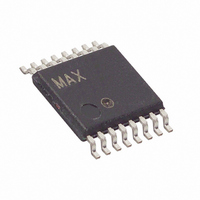MAX6698UE38+ Maxim Integrated Products, MAX6698UE38+ Datasheet - Page 14

MAX6698UE38+
Manufacturer Part Number
MAX6698UE38+
Description
IC TEMP MONITOR 7CH 16-TSSOP
Manufacturer
Maxim Integrated Products
Datasheet
1.MAX6698EE99.pdf
(24 pages)
Specifications of MAX6698UE38+
Function
Temp Monitoring System (Sensor)
Topology
ADC, Buffer, Multiplexer, Register Bank
Sensor Type
External & Internal
Sensing Temperature
-40°C ~ 125°C, External Sensor
Output Type
I²C™/SMBus™
Output Alarm
Yes
Output Fan
Yes
Voltage - Supply
3 V ~ 5.5 V
Operating Temperature
-40°C ~ 125°C
Mounting Type
Surface Mount
Package / Case
16-TSSOP
Full Temp Accuracy
+/- 3.5 C, +/- 3 C
Digital Output - Bus Interface
Serial (2-Wire)
Digital Output - Number Of Bits
11 bit
Maximum Operating Temperature
+ 125 C
Minimum Operating Temperature
- 40 C
Lead Free Status / RoHS Status
Lead free / RoHS Compliant
channel 1. The series resistance cancellation function
increases the conversion time for channel 1 by 125ms.
This feature cancels the bulk resistance of the sensor
and any other resistance in series (wire, contact resis-
tance, etc.). The cancellation range is from 0 to 100Ω.
When the remote-sensing diode is a discrete transistor,
its collector and base must be connected together. Table
11 lists examples of discrete transistors that are appropri-
ate for use with the MAX6698. The transistor must be a
small-signal type with a relatively high forward voltage;
otherwise, the A/D input voltage range can be violated.
The forward voltage at the highest expected temperature
must be greater than 0.25V at 10µA, and at the lowest
expected temperature, the forward voltage must be less
than 0.95V at 100µA. Large power transistors must not be
used. Also, ensure that the base resistance is less than
10Ω. Tight specifications for forward current gain (50 < ß
<150, for example) indicate that the manufacturer has
good process controls and that the devices have consis-
tent V
sistors do not normally specify or guarantee ideality
factor. This is normally not a problem since good-quality
discrete transistors tend to have ideality factors that fall
within a relatively narrow range. We have observed varia-
7-Channel Precision Remote-Diode, Thermistor,
and Local Temperature Monitor
Table 8. Status 1 Register
14
7(MSB)
BIT
______________________________________________________________________________________
6
5
4
3
2
1
0
BE
characteristics. Manufacturers of discrete tran-
Thermistor 3 ALERT
Thermistor 2 ALERT
Thermistor 1 ALERT
Remote-Diode 3
Remote-Diode 2
Remote-Diode 1
Local ALERT
Reserved
ALERT
ALERT
ALERT
NAME
Discrete Remote Diodes
POR STATE
0
0
0
0
0
0
0
0
—
Local Channel High-Alert Bit. This bit is set to logic 1 when the local temperature
exceeds the temperature threshold limit in the local ALERT high-limit register.
Thermistor 3 Alert Bit. This bit is set to logic 1 when the thermistor 3 voltage
exceeds the threshold limit in the thermistor 3 ALERT high-limit register.
Thermistor 2 Alert Bit. This bit is set to logic 1 when the thermistor 2 voltage
exceeds the threshold limit in the thermistor 2 ALERT high-limit register.
Thermistor 1 Alert Bit. This bit is set to logic 1 when the thermistor 1 voltage
exceeds the threshold limit in the thermistor 1 ALERT high-limit register.
Channel 3 Remote-Diode High-Alert Bit. This bit is set to logic 1 when the
channel 3 remote-diode temperature exceeds the programmed temperature
threshold limit in the remote 3 ALERT high-limit register.
Channel 2 Remote-Diode High-Alert Bit. This bit is set to logic 1 when the
channel 2 remote-diode temperature exceeds the temperature threshold limit in
the remote 2 ALERT high-limit register.
Channel 1 Remote-Diode High-Alert Bit. This bit is set to logic 1 when the
channel 1 remote-diode temperature exceeds the temperature threshold limit in
the remote 1 ALERT high-limit register.
tions in remote temperature readings of less than ±2°C
with a variety of discrete transistors. Still, it is good design
practice to verify good consistency of temperature read-
ings with several discrete transistors from any manufac-
turer under consideration.
If one or more of the remote diode channels is not need-
ed, the DXP and DXN inputs for that channel should
either be unconnected, or the DXP input should be con-
nected to V
"fault" for this channel and the channel is ignored during
the temperature-measurement sequence. It is also good
practice to mask any unused channels immediately upon
power-up by setting the appropriate bits in the
Configuration 2 and Configuration 3 registers. This will
prevent unused channels from causing ALERT# or
OVERT# to assert.
The MAX6698 can use three external thermistors to
measure temperature. A thermistor’s resistance varies
as a function of temperature. A negative temperature
coefficient (NTC) thermistor can be connected between
the thermistor input and ground, with a series resistor,
REXT_, connected from the thermistor input to VREF.
CC
FUNCTION
. The status register indicates a diode
Thermistor Measurements
Unused Diode Channels











